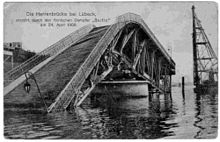Herrenbrücke (Herrenwyk)

The Herrenbrücke was a road bridge that crossed the Trave in the course of the Travemünder Allee ( B 75 ) between Lübeck and the district of Travemünde in the district of Herrenwyk . The waterway called Untertrave here connects Lübeck with Lübeck-Travemünde and flows into the Baltic Sea .
The terms Herrenbrücke and Herrenwyk are derived from the word herring , which was caught here in large quantities due to a natural narrowing of the Trave.
history
In 1901 the then even more meandering Trave was expanded to facilitate shipping to the port of Lübeck and straightened its course . As part of this, a new breakthrough was created in the area of Herreninsel, which had to be crossed with a bridge for road traffic. This was done through an iron swing bridge , which also served the tram . Construction of the bridge began in April 1901, it was cleared for road traffic on April 1, 1902, and shipping followed from October 1902.
During the economic boom , the old bridge, which had only two lanes at 5.4 m wide, became too small, so that from September 1, 1960, a new, larger bascule bridge was built next to the old swing bridge . After the clearance of what was then the largest bascule bridge in Europe on August 4, 1964, the old bridge was dismantled. The new Herrenbrücke with two separate two-lane lanes now had four folding elements (two for each direction of travel) and had a clear width between the two river pillars . This made it possible to widen and deepen the fairway of the Untertrave. The greater height of the new bridge required longer access roads on both banks with a length together with the foreland bridges of around 550 meters, but enabled many ships up to 22 meters high to pass through without a special bridge opening, so that road traffic is no longer as frequent as it used to be had to be interrupted. Due to construction errors, however, there were problems with the folding mechanism from the start. The bridge did not open and close reliably, often creating dangerous situations. If it could not be opened or not in time, ships that wanted to pass the bridge had to avoid a collision with the structure with full reverse speed. If it could not be closed after a ship passage, it caused long traffic jams on the busy road.
A story from the responsible architect tells that he threw himself off the Herrenbrücke because of the innumerable defects. However, this has not yet been proven. The city of Lübeck invested large sums of money in the bridge, which was once the pride of the city, in the course of its lifetime for modification measures to make the bridge more reliable and for maintenance. However, the folding mechanism was never reliable. In addition, insufficiently grouted tendons were found on the ramp bridges made of prestressed concrete , which showed so much corrosion that online monitoring of the deformations of the bridge was installed from 2000 and the maximum permissible vehicle weight was limited to 40 tons.
The city of Lübeck therefore decided to have a tunnel built as a replacement structure .
Replacement of the bridge by the Herrentunnel
On August 26, 2005, the bridge was replaced by the privately financed, toll-based Herrentunnel . In the period from August 2005 to September 2006 the bridge was demolished.
For pedestrians and cyclists, however, this solution is a deterioration because they are only allowed to cross the tunnel in shuttle buses operated by the Lübeck-Travemünder Verkehrsgesellschaft (LVG). However, depending on the timetable, this service, which is free for the user, can result in certain waiting times.
Special
In 1996 the Herrenbrücke played a leading role in the television show “ Wetten, dass ..? ". In the outside bet, the sailing training ship Khersones drove through the open bridge hatches and operated switches attached to the bridge with the Rahnocken .
On November 10, 2005, Greenpeace used the bridge to block ship traffic on the Trave with ropes, thus demonstrating against the forestry policy of the Stora Enso group in northern Finland . The majority of Finnish paper exports took place via the port of Lübeck.
literature
- Rainer Wiedemann: The last flap: Farewell to the Herrenbrücke Lübeck . Thomas Helms Verlag , Schwerin 2011, ISBN 978-3-940207-74-6 .
Individual evidence
- ↑ Telephone monitoring for a bridge. In: Lübeck city newspaper. March 25, 2003. Retrieved November 19, 2008 .
- ↑ Greenpeace protests in Lübeck against the destruction of the jungle. In: na presseportal. November 10, 2005, accessed June 27, 2014 .
Web links
Coordinates: 53 ° 54 ′ 6 ″ N , 10 ° 46 ′ 21 ″ E



